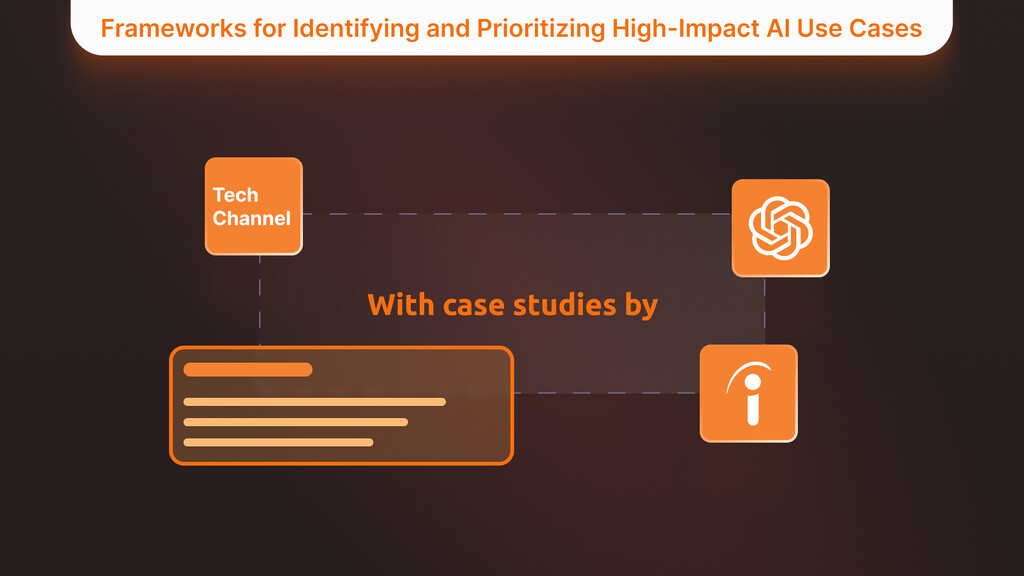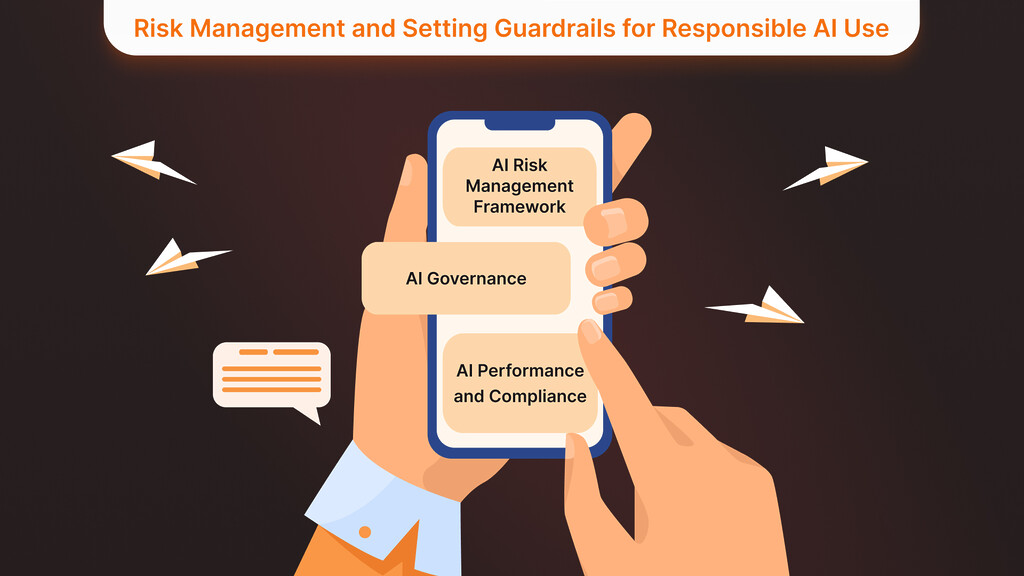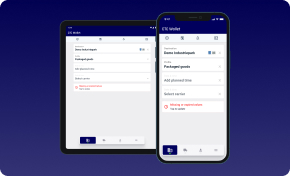Part 1 of the Enterprise AI Integration Playbook series laid the groundwork for enterprise AI integration, covering why AI is a strategic imperative and how organizations should prepare themselves for the adoption of AI.
Part 2: It is now time to transition to strategic planning, creating a concise roadmap that aligns AI initiatives with business objectives and prepares for effective implementation. This is done in terms of high-impact use cases identification, prioritization of projects, risk management, and governance structure definition during planning.
This requires a leadership-based plan that is well thought out, as most AI initiatives fail due to a lack of a systematic approach. With effective planning, businesses can move beyond AI hype and into real ROI and sustainable innovation.
Developing an Enterprise AI Integration Roadmap
An AI integration roadmap is the starting point of strategic planning: it is a step-by-step plan that connects AI initiatives with your organization’s goals and schedules. This roadmap is a guide in the form of a blueprint for the preliminary evaluation to implementation.
It should detail how you will assess and choose AI projects, what capabilities and resources you will require, and how you will roll out the adoption of AI enterprise-wide. Importantly, the roadmap should align AI projects with the company’s strategic objectives.
Streamlining Your Path to Effective Product Discovery
Make Your Ideas a Reality in Four Weeks with Our Results-Driven TechBoost Program
See Product Discovery ServicesPractically, this translates to identifying and prioritizing AI opportunities that align with important business goals (e.g., revenue growth, cost reduction, customer experience) and planning them in a rational order.
Key components of an AI roadmap
Many of them contain an evaluation of the current situation (data, technology, skills), a vision of AI in the business, a step-by-step implementation plan, and well-defined measures of success. To illustrate, one of the CIO guides proposes classifying AI projects based on their impact and feasibility, allowing resources to be actively distributed and ensuring that the highest-value projects are addressed first.
The roadmap must also include a timeline, e.g., targeting the production of first AI pilot outcomes within 6-12 months and achieving enterprise-scale impact in 12-24 months. Most organizations that have achieved success in adopting AI use a step-by-step strategy: conducting quick pilot tests to prove effectiveness, and then implementing and expanding those solutions that have been confirmed. This is a balance of short-term victories and long-term change.
AI Roadmap- living strategy document
Notably, consider the AI roadmap as a dynamic strategy plan. The roadmap must be reconsidered and updated as AI technologies and business conditions evolve. An organized roadmap is not a fixed plan; it is guidance that keeps AI activities on track and in order. When you map out initiatives on a roadmap, you will not end up with random experiments in AI, but rather a deliberate program in which each project leads to enterprise-level capabilities.
Case in point
A clear AI path was determined, where an e-commerce enterprise began with a vision workshop and the detection of use cases. During the initial 3 months, the leadership agreed on the role of AI that would drive the strategic goals (e.g., conversion rates), defined the AI Center of Excellence to govern AI projects, and created the list of priorities of AI projects.
This roadmap helped them initiate a pilot of personalized product recommendations (using readily available customer data) as their first project to increase online sales. They kept stakeholders and their roadmap on track by rolling out in phases, pilots followed by wider rollout. The roadmap also clearly jumped over integration hurdles at the beginning (such as data silos and legacy systems), which allowed the company to foresee and to surmount the challenges that may sink AI projects.
Frameworks for Identifying and Prioritizing High-Impact AI Use Cases

Having a roadmap in mind, companies require an organized system to determine and prioritize the use cases of AI. Not all problems require AI, and there are limited resources to work on, so it is essential to engage with high-impact, feasible opportunities. Begin by brainstorming possible applications to use cases by department, involving stakeholders with a sense of the pains and opportunities in the business.
Each idea should be evaluated in terms of its potential value and feasibility. Good planning requires being hard on yourself early on: Does this use case answer a real business problem? Is it part of our strategic priorities? Do we have the numbers and the technology to carry it out?
Accelerate Your Growth with IT Consultancy
Propel Your Business with Expert Tech Insights
Discover IT ConsultingCase Study: TechChannel
According to the AI adoption roadmap provided by TechChannel, organizations are expected to conduct a consistent review to determine whether a particular problem requires AI or if a simpler process optimization can be sufficient. This guards against the pursuit of AI to be AI.
The Impact/Effort matrix is a popular prioritization technique, where each use case is scored as a function of the business value (impact) it may bring to the table, against the effort (complexity) to implement it.
Case Study: OpenAI
Projects that are high-impact and low-effort (so-called quick wins) become prioritized, while those that are low-impact or those where the effort is prohibitive might be shelved. Indeed, this is precisely what being an enterprise advisor at OpenAI means when the framework is a simple quadrant of value to the company and implementation effort. This can help clear out low-value or overly complex initiatives and identify the “high-ROI” opportunities to address first.
The other useful framework is to develop a standard AI use case evaluation framework. This template includes the main points of each idea, such as the business opportunity being addressed, the anticipated benefits, the information and technology required, the costs, compliance or ethical issues, and feasibility or readiness aspects. Scoring or rating each factor allows the organization to compare various AI ideas on equal grounds.
Tech leaders suggest a simple scoring structure to prioritize tasks, such as potential impact, ease of implementation, and strategic alignment per use case, and add the scores accordingly. Your best bets are probably the highest-scoring use cases.
Case Study: Indeed
As an example, Indeed (the job site) took a strict review and chose to invest in an AI component that clarified job suggestions to the users. It did not come easily; this build took months of testing and iteration, but the payoff was obvious: when job seekers had transparency into their applications, engagement improved (a 20% increase in job applications initiated).
The example of Indeed demonstrates a high-impact use case (user trust and conversion) that necessitated a lot of effort and eventually paid off in terms of ROI. On the other hand, there will be ideas that are in the quadrant of “low impact” or “not worth it”, e.g., creating a personalized AI to create web forms when an efficient tool can be used. An effective framework will guide you in working on projects that create new value, rather than reinventing the wheel.
To assist your team in organizing this selection process, apply the following decision factors to screen AI use cases:
| Evaluation Criterion | Key Questions |
| Business Impact | What can this AI solution bring? Is it revenue growth driver, cost savings, efficiency or other strategic KPIs? A use case with a high impact deals with a major pain point or opportunity. |
| Feasibility | is the technology present and old enough to fix the problem? Do we possess enough (quality, quantity) data and technical ability of applying the solution? Take into consideration any form of integration complexity with existing systems. |
| Strategic Alignment | Is the use case aligned to our core business interests and priorities? Make sure every AI initiative is aligned with the mission of the company instead of a stand-alone experiment. |
| Risk and Compliance | What risks (ethical, legal, security) are there in the event that we adopt this AI solution? Are they something we can tame through good controls? The regulatory or ethical limits still have to be balanced against high-impact use cases. |
| Time to Value | How long will it take to deliver and gain value? The AI program can be given an initial boost by quick wins that show initial success, but multi-year moonshots are more uncertain. |
This framework helps teams evaluate use cases in a non-subjective manner. As an example, you may rate each of the criteria on a 1-5 scale of a given idea and come up with a composite score. In addition to scoring, qualitative judgment is also important: engage cross-functional experts (such as business managers, data scientists, IT architects, and others) in the discussion to clarify the merits of each idea.
It is not uncommon to hear domain experts mention practical concerns, e.g., a logistics manager may point out that an AI model to predict delivery delays will be useless unless certain real-time data feeds are available. This type of input ensures that the chosen use cases are not only high-impact but also feasible in the real world.
Aligning AI Initiatives with Core Business Goals and Pain Points

One key to success in strategic planning is to ensure that AI initiatives align with your organization’s core objectives and targets, and address actual business pains. Integrating AI and business strategy implies that it begins not with the question What can we do with AI?, but with “ What are our most urgent business problems or opportunities – and can AI provide solutions to them?
This, in practice, involves tight coordination between the business and technical teams in the initial stages. The leadership must be able to define the most important business goals (e.g., enhancing customer retention, maximizing the effectiveness of a supply chain, lowering operational costs) and then find AI applications that would drive the progress towards such goals.
And as one industry guide wrote, to get real value out of investments in AI, it must be aligned; AI initiatives cannot live in a vacuum or simply be undertaken because competitors are exploring them.
Executive Workshops
A best practice suggestion is to utilize executive workshops or strategy sessions, and then map AI opportunities to strategic priorities. For example, when a company aims to improve customer experience, the use cases of AI that may emerge during the workshop may include personalized recommendations or an AI-based customer service agent, all of which are related to the objective.
Defining success: It is necessary to define what success means by clearly defining business KPIs for AI projects (e.g., converting X% more people, decreasing the average handle time of a customer support call by Y minutes) so that everyone knows what the AI is aiming for. This helps the team maintain focus on measurable outcomes, rather than cool technology.
Pain Points
It is also very important to address the actual pain points that customers and workers have to deal with. The problem that AI solutions need to solve should be specific: it can be a slow manual process, an inefficiency, a prediction that will save money, or an experience that can be improved. The involvement of frontline teams can reveal pain points that are ready to be targeted by AI.
For example, a bank’s fraud department may struggle to review transactions manually, which suggests that AI can be applied to automate the process of detecting fraud. The AI initiative will be more likely to be supported and provide actual value by finding a real pain point. Conversely, when chasing AI around a loose or fad-related concept without well-defined pain points in mind, the results tend to be a mess of efforts and squandered resources.
It is not uncommon to find organizations that have been misled into implementing AI simply because it is the latest trend or because a rival organization has done so, yet fail to deliver due to a lack of attention. To prevent this, outline particular results and implement frameworks such as OKRs (Objectives and Key Results) to connect AI work with business outcomes.
Cross-Department Cooperation
Another pillar of alignment is cross-department cooperation. AI projects often break across silos —an example of this is a predictive maintenance AI that requires access to both Operations (asset data) and IT (sensor feed integration). During the planning phase, include all the concerned stakeholders so that the solution is not only feasible but also adopted.
An AI steering group that is cross-functional can decide upon AI use cases that have the support of many sections of the business, and render obsolete those that are not. The cooperation will enable AI solutions to respond to the practical limitations of the real world, avoiding the neglect of essential considerations in operational contexts. It can also facilitate change management; early adoption by various teams facilitates the subsequent implementation of change.
In a nutshell, the business-oriented approach to aligning the AI initiatives is a matter of strategy. Any AI project in your roadmap must be traceable to one of the high-level goals or problems. Unless you know how an AI project will help achieve a key business goal or remove a well-understood pain point, then you should ask yourself why you are doing it.
Maintaining AI as business-centric makes it a program that delivers results rather than a science project. It is this alignment that makes the difference between enterprise AI winners and wishful thinkers, so that AI leads to a real, measurable difference and does not end up in the proof-of-concept stage.
Risk Management and Setting Guardrails for Responsible AI Use

In the eagerness to design AI initiatives, companies should not lose sight of risk management and the development of guardrails of responsible AI. AI projects present risks of their own, such as ethical ones (such as biased decision making) or regulatory and security risks, and strategic planning is the moment to foresee and prepare to avoid them.
A Responsible AI framework should be incorporated into the planning to make sure that the implementation of AI does not break the law, ethics, and trust of people. This will include the establishment of rules and governmental systems, which will serve as guidelines to ensure that AI systems comply with the organization’s standards, policies, and values.
AI Risk Management Framework
To begin with, it is helpful to embrace formal AI risk management frameworks. As an illustration, RMF AI by NIST offers instructions on how to discover and address risks throughout the AI lifecycle. In the same way, you can be guided by ISO/IEC 42001 or industry-specific guidelines. AI risk management aims to reduce the possible adverse effects of AI and maximize the positive implications in a systematic manner.
This practically implies that this should be evaluated on every proposed use case: What can go wrong if this AI makes a mistake? Is it likely to discriminate or infringe on privacy unintentionally? What do we do to make the system fail-safe against misuse or attack? It is best to ask such questions early in order to incorporate safeguards into the project plan.
Custom Software Development for a Competitive Edge
Build Unique Software Solutions with Our Expertise
Explore Custom SoftwareAs an example, when designing an AI that will work with personal data, you will need to incorporate privacy safeguards and compliance checks in the initial design.
AI Governance
The key factor here is AI governance. AI governance aims to outline the broad principles that ensure AI tools and systems are safe and ethical, and will continue to be so. It consists of the committees, policies, and procedures that regulate the use of AI. In strategic planning, identify the guardrails that your organization may require (this may be technical, e.g., content filters to detect inappropriate AI outputs, procedural, e.g., model validation and bias testing before deployment, and policy-based, e.g., an AI ethics code of conduct).
Top companies define strict responsible AI principles (such as fairness, transparency, and accountability) and incorporate them into project requirements. One example is that guardrails may require any AI system used in making customer-facing decisions to be explainable and auditable, preventing the use of so-called black box results that cannot be rationalized.
McKinsey highlights that guardrails are a key to responsible AI use, as they would help to check outputs and filter such problems as toxic content or misinformation (especially topical in the case of generative AI systems). Although the introduction of guardrails cannot eliminate the risks, the probability of committing a severe ethical or compliance violation will decrease significantly.
AI Performance and Compliance
Risk management that is proactive also involves planning for continuous monitoring. Think of the way you will track AI performance and compliance after systems are live. This may include the installation of dashboards that display critical risk signals (e.g., model accuracy drift, anomaly detections, bias measures), as well as routine audits, also known as health checks, of AI models.
Most organizations establish an AI ethics or review board that routinely reviews the deployment of AI in a responsible manner. Roles and responsibilities of this oversight should be allotted by the strategic plan (more on governance roles in the following section). It is important to bear in mind that AI risks are cross-functional, to reflect the fact that they cut across a variety of areas, including data privacy, model security, legal liability, and reputational risk.
According to research conducted by IBM, executives are well aware of AI risks (96% of leaders agree that the use of generative AI increases the chances of a security breach), However, today, only a quarter of AI initiatives are sufficiently secured. It is clear that some work should be done in bridging this gap.
This is because, by including risk mitigation in the plan, you can ensure that the AI initiatives are delivered with the required safety nets, as opposed to being an ungoverned experiment.
Overall, being responsible in AI usage is not only a compliance box, but a strategic advantage. When performed properly, the practice of responsible AI reduces risk, enhances AI performance, and fosters trust. Early guardrail setting (in areas such as data usage, model training, deployment, and monitoring) does not slow down the value creation process; rather, it speeds it up by avoiding expensive mistakes and rework in the future.
Good governance of AI, as one governance expert put it, is not a slowdown: it is the avoidance of the six-month slowdowns that come when you have to go back and remediate when compliance goes wrong. Therefore, by incorporating risk management into the process early in the development of your AI program, you can ensure that the program grows in scale and with integrity, protecting both stakeholders and the enterprise it supports.
Organizational Roles and Governance in the Planning Stage
Strategic AI planning is not only a technical endeavor but also an organizational one. The planning phase of AI integration requires defining proper roles, teams, and governance structures that will ensure the success of your AI integration.
One of the most frequent best practices is to have an AI steering committee or an AI governance committee early in the process. This cross-functional group is a strategic oversight, prioritization, and accountability group. Importantly, it unites stakeholders throughout the enterprise, which is not a technology project, but rather a business transformation that requires a wide ownership.
Who is to be involved?
An AI governance committee or a Center of Excellence (CoE) must have a leader mix that is multidisciplinary. Generally speaking, this involves: technical people (AI/ML leads, data scientists, IT architects), business unit leaders who will sponsor and consume AI solutions, legal/compliance and risk management, and perhaps an ethics or HR representative to address workforce issues.
Experience Our Skilled Development Teams
Elevate Your Projects with Skilled Software Development Professionals
Get Your Development TeamThe importance of senior executive sponsorship cannot be underestimated – frequently, the CIO or another C-level executive sponsor will chair the committee to emphasize the significance of the effort. With technical, legal, ethical, and business expertise, the group can consider AI plans comprehensively and mitigate problems beforehand. According to Tech Jacks Solutions, organizations without an official AI governance committee are typically more exposed to regulatory and reputational risks, whereas those with an AI governance committee can identify and address problems during planning sessions.
That is, proactive management, as opposed to reactive crisis management, is the result of the right people in the room.
Governance Roles and Responsibilities
In the planning phase, make sure that the roles and responsibilities of the governance of your AI program are defined clearly. It may be useful to use a RACI (Responsible, Accountable, Consulted, Informed) model of main tasks. As an example, who gives permission to new AI projects? Who is there to ensure that models are ethical? Who deals with change management and training of staff?
Specification of these roles will eliminate confusion in the future. To increase the longevity of the Center of Excellence, many organizations formalize the AI Center of Excellence by creating a charter to address its mandate (e.g., to centralize AI strategy, governance, and knowledge sharing), authority (its decision-making power), and membership. This CoE can lead in the implementation of the integration roadmap, provide business units with expertise, uphold standards, and best practices across projects.
Communication Channels
Governance in planning implies the establishment of channels of communication as well as decision-making. The AI steering committee may schedule frequent meetings (e.g., monthly) to discuss project proposals, progress on the roadmap, and to clear up escalated issues. It must report to the executive level or, in some cases, to the board, as AI investments are high stakes.
Project teams to work on each of the prioritized use cases ought to be formed at the working level, and they usually consist of a combination of business domain knowledgeable, data scientists/engineers, and IT support. These departments will be the ones to implement their AI plan, but the governance committee plays an oversight role and gives direction to these teams so that their work falls into the overall strategy and complies with the governance policies.
Change Management and Culture
The last point that should be considered is the organizational change management and culture, even on the planning level. The implementation of AI will impact the job and workflow of people; thus, including HR and department heads in the governance process will enable the preparation of training and upskilling plans, discussion of employee concerns, and necessary job redesign.
Digital Transformation for Competitive Advantage
Empowering Your Business with Tailored Digital Solutions
Explore Digital TransformationGovernance is not only about policing risks, but it is also about leading the organization to change. A cross-functional steering group can promote AI across departments, share success stories, and help build an AI-ready culture. It literally turns into an internal AI leadership team. Other firms, such as eBay (mentioned in our LinkedIn case), establish an AI leadership model to unite all organizational grades with the AI vision.
To conclude, what makes the playbook of AI integration work is strong governance and well-defined roles. They ensure you have both high-level and ground-level coordination to implement in the planning process. When you have an AI governance committee, you establish an early warning system for potential problems, such as bias or privacy issues, and establish guardrails during development, thereby promoting coordination across silos.
Not only does this mitigate risk, but it also increases the speed of progression; teams are free to innovate without fear that checks and balances are not in place. It is during the planning phase that this governance framework should be nailed. It will repay itself many times in the future, as the program will be disciplined, oriented towards business values, and supported by all key stakeholders within the enterprise.
Key Takeaways (Part 2)
- Build a concrete AI roadmap: Create a step-by-step integration strategy, starting with small pilots and progressing to enterprise-level implementation, ensuring each stage is connected to your business strategy. A living roadmap gives you direction and shape to your AI journey.
- Drive high-impact use-cases: Utilize frameworks (impact vs. effort matrices, scoring criteria) to objectively assess AI opportunities. Emphasize projects that are of high business value, can be implemented, and align with the central objectives, and postpone low-value or high-risk concepts.
- AI should be aligned to business: Make sure to tie any AI project to a business necessity or opportunity. Engage business stakeholders to ensure that AI projects address relevant problems and are supported by appropriate measures of success (e.g., KPI targets). There should be no AI for the sake of it, but AI should be strategically relevant.
- Embed in risk management and responsible AI guardrails: Think in advance how you are going to address the risks of AI (bias, privacy, security, regulatory compliance). Create ethical principles, validation systems, and monitoring to ensure the safety of AI systems, their fairness, and adherence to your values. Being proactive in governance will help avoid financial losses due to mistakes and gain trust.
- Define governance and roles early: have a cross-company steering committee or Center of Excellence in AI to manage the AI strategy. Make decision-makers and result-makers clear. Solid governance during the planning process holds everyone accountable and keeps AI initiatives on course for long-term success.
With a strategic plan and vision regarding enterprise AI integration, you will create the conditions under which AI projects will be powerful, responsible, and scalable. In the second part of this series, we will pick this up and go into the implementation phase, to bring the roadmap into practice by starting pilot projects, implementing technology, and learning by doing. Now, with a sound strategy at hand and a leader to point the way, the road to AI excellence in the enterprise is traveled.
How do you choose the best AI use cases for your business?
To identify high-impact AI applications, start by learning more about your business objectives and pain points. Apply models such as the Impact vs. Effort framework to assess ideas based on their value, practicability, and alignment with strategic priorities. Concentrate on real problem-solving use cases and not necessarily on those that appear to be innovative.
What’s the expected ROI from AI integration, and how soon can we see it?
AI projects can pay off in 6-12 months during pilot projects. Full-scale impact is usually seen after 12-24 months. Measuring KPIs such as cost savings, customer retention, or increased productivity can demonstrate ROI and justify continued investment in AI.
What is an AI roadmap, and why is it essential for enterprise success?
An AI roadmap is a strategic plan that guides your AI projects from concept to execution. It establishes priorities, timeframes, milestones, and resource allocations. A living roadmap will keep your integration activities on track with your business goals and ensure the process proceeds at a steady pace.
Why is strategic planning critical for successful AI adoption?
Strategic planning makes AI activities align with actual business requirements. It eliminates scattered efforts, minimizes risk, and enhances resource use. Planning helps you define success, assign roles, and make your organization AI-effective.
How can you align AI initiatives with core business goals?
Begin with your most significant business issues —such as customer loss, inefficient processes, or fraud —and determine how AI can be used to resolve them. Assign AI initiatives to measurable business KPIs using OKRs or similar frameworks.
What are the common risks in AI implementation, and how can we mitigate them?
Data bias, model inaccuracies, a lack of explainability, and compliance violations are among the common risks. These can be managed using a Responsible AI framework, proactive governance, legal and ethics oversight, and through continuous monitoring during and after deployment.
What does a Responsible AI framework include?
A responsible AI framework is one that ensures fair, transparent, and accountable AI construction and use. It incorporates policies on data governance, model explainability, and ethical review mechanisms and validation processes to safeguard users and mitigate compliance risks.
Who should be involved in AI governance and decision-making?
Form a cross-functional governance team comprising executives, data scientists, legal/compliance leads, and business unit stakeholders. Best practices, priorities, and responsible AI implementation are ensured through executive sponsorship and assigned roles.
How do you measure the success of an AI project?
Success is measured by business-driven KPIs: more revenue, lower costs, quicker turnaround time, or better customer satisfaction. These metrics should be defined through strategic planning and tracked during the lifecycle.
How mature does your data infrastructure need to be for AI integration?
Implementing AI requires data quality, well-organized, and powerful pipelines. In case your data is siloed, unstructured, or incomplete, it may slow down or derail projects. The playbook recommends auditing data preparedness early to prevent project failure.
What technical elements are required to integrate AI into web and backend systems?
To be successful, APIs for model access, data pipelines to feed real-time data, scalable compute (e.g., GPUs, TPUs, cloud AI), and model monitoring tools are needed. This is because planning these parts early avoids delays and architectural mismatches in the future.
How often should you update your AI roadmap or strategy?
The AI strategies are to be reviewed after 6-12 months to reflect changes in business objectives, new technologies, or compliance requirements. A dynamic roadmap allows you to stay ahead of the competition and avoid being bound by stagnant plans.
How can you avoid wasting money on AI projects that don’t deliver?
Use cases related to business impact should be the starting point of doing AI, not because it is AI. Confirm that every project has a strategic fit, is feasible, and has data ready to invest. Pilot test results, scale, and measure only results that succeed.
What role does company culture play in AI adoption?
Culture influences team trust and the adoption of AI tools. Those organizations that encourage experimentation, training, and change management have an open approach to change and adopt it faster and more effectively. Involving HR and change managers in the planning process can help build AI preparedness.
How do you prioritize AI projects when resources are limited?
Rank the initiatives according to their impact on the business, technical capability, fit with the strategy, and risk potential, using scoring frameworks. Initially, focus on projects with the highest impact and fastest win rates that justify the value of AI, and move on to more complex application cases later.










